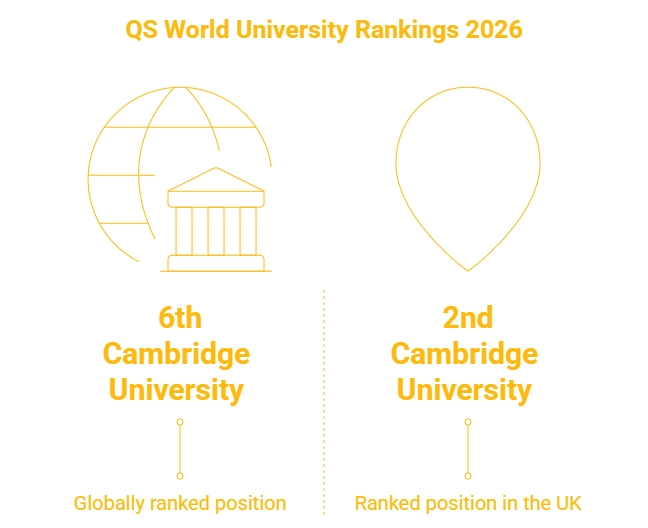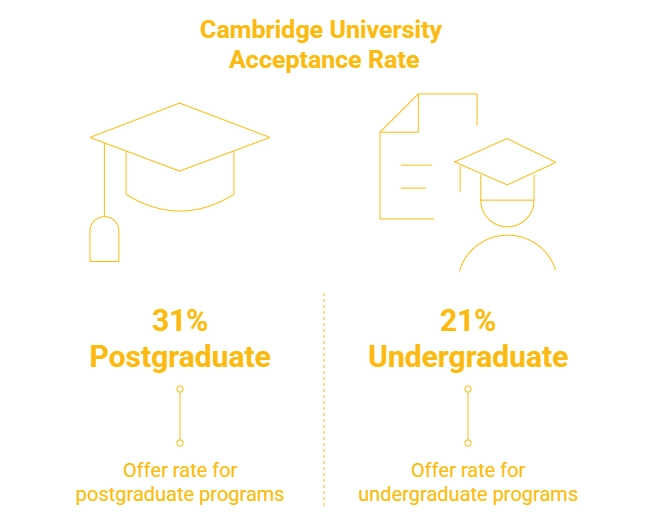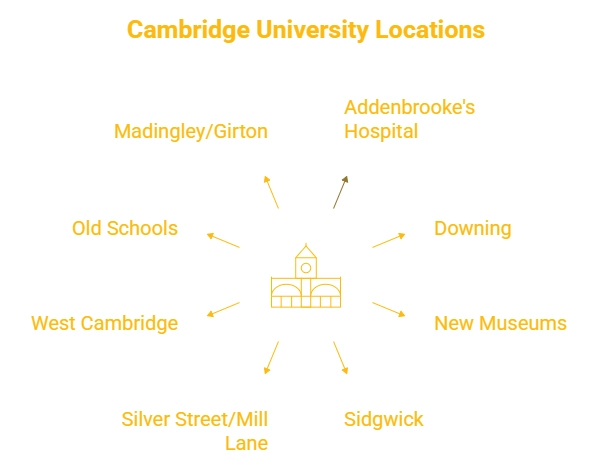Founded in 1209, Cambridge University is among the oldest universities still running. Ranked as a top-five global institution, its standing shows its great faculty, collaborative research, and history of important academic work. UCAS data places it in the top three for research quality. Cambridge has a £2.62 billion endowment and a £2.24 billion budget (2023/24), which supports excellent facilities and education.
Cambridge University has consistently maintained its position. According to the QS World University Rankings 2026, it holds the 6th position globally, which confirms its good academics and global name. In the UK, it is ranked 2nd, showing its popularity among the students from both the UK and other countries.

Getting an admission in Cambridge University is highly competitive. About 21% of undergraduate applicants get an offer, which is roughly 1 in 5. For postgraduate programs (both taught and research), the offer rate is about 31%.

*Need assistance to study in UK? Y-Axis is here to assist you in all the ways.
Cambridge has several locations, such as:

This close relationship between the university and the city helps create a lively academic and social atmosphere, since many resources are nearby.
Cambridge has 31 autonomous colleges and a lot of academic choices:
Courses include fields like Humanities, Sciences (including Mathematics, Engineering, and Medicine), Social Sciences, Architecture, Law, and Business. Cambridge's education is strong because of its varied courses and focused teaching in each college.
| Level | Annual Tuition Fee (GBP) |
| Undergraduate | £27,024 – £70,554 |
| Postgraduate | £24,700 – £69,000 |
Note: Costs vary significantly by course and college fees. Living costs are about £14,600 each year.
Cambridge gives awards such as:

These show Cambridge supports students based on merit and promotes diversity.
Cambridge guarantees college-owned accommodation for almost all undergraduates for at least three years
Girton College details:
Living in college-owned accommodation puts students close to classes and fosters a sense of community. After their first few years, many students choose to move into private housing.
Step 1: Applications should be submitted through UCAS by mid-October for entry in October.
Step 2: Applicants must fill out the My Cambridge Application, which includes choosing a college and course, and providing personal details.
Step 3: Some subjects like Arts and Law, may require submission of written work or a portfolio.
Step 4: Depending on the course, applicants may need to attend an interview or complete an admissions assessment such as STEP, BMAT, or TSA.
Step 5: Offers are usually given in winter and are conditional, depending on A-level or IB results.
Step 6: Admission is confirmed once the required conditions are met after the results are released.
Australia Student Visa
Akshay applied for a Student visa for Au
Read More...
Australia Student Dependent Visa
Sameera applied for a Student visa for A
Read More...
Australia Student Visa
Prashanth Sikhamani came to us as he was
Read More...
Suppose you are not a native English speaker living in the UK or a Permanent Resident of a non-English speaking nation. In that case, you must take the English Language Test (ELT) in Australia as part of your student visa. There are several types of ELT in Australia; you need to choose the correct ELT specified by your university in Australia for the course you are pursuing. Below are the minimum scores required to score for ELTs in Australia.
| English Language Test | Minimum Overall Score |
| IELTS | 5.5 |
| TOEFL | 46 |
| CET | 162 |
| PTE | 42 |
| Occupational English Test | ‘B’ for each test component |
The following are the variations in work permissions and other related differentiations under the Australia Study Visa:-
| Categories of differentiation | Visa (Subclass 485) | Visa (Subclass 500) | Visa (Subclass 590) |
| Cost of Visa | AUD 1730 | AUD 650 | AUD 650 |
| Work Permissions While Studying | Study Visas after April 2008 automatically make you eligible to work:- -For unlimited hours when your course is not in session | ||
| Work Permit After Completing Education | Note that English Language Proficiency courses pursued by international students can’t be used to fulfill Australia Study Visa Requirement.
So these courses can’t be counted for Post Study Work Permit under sub-class 485 |
International student who complete Australian study requirement, are eligible to apply for Post-Study Work Permit under both subclasses. | |
| Exceptions (if any) | In case an international student has been asked to take an English language course as a forerunner to admission to a regular degree/diploma course, the international student must apply for a student visa that is eligible for the main course. | In case the course duration doesn’t match the Australian Study Visa Requirement, the international student can undertake 2 or more programs that will be added to check his/her eligibility for a Post Study Work Permit. | In case your visa expires before you complete your graduation, then as an you can apply for a visitor visa.
You need to provide a letter from your Australian university/ institute that states the upcoming date of your graduation in the course. |
| S. No. | Post-Study Work Visa | Key Features |
| 1. | Skilled-Recognised (Subclass 476) Graduate Visa | Applicable for Engineering graduates |
|
|
| Stay duration up to 18 months |
|
|
| Processing time 8 months to 11 months |
|
|
| Visa cost Starts from AUD 405 |
|
|
| Visa type Temporary |
|
|
| Allows you to bring the family with you |
| 2. | Temporary Graduate Visa (Subclass 485) for Graduate Work Stream | Applicable for recent graduates |
|
|
| Stay duration up to 18 months |
|
|
| Processing time 90 days to 4 months |
|
|
| Visa cost start from AUD 1650 |
|
|
| Visa type is temporary |
|
|
| Allows you to bring your family with you |
| 3. | Temporary Graduate Visa (Subclass 485) for Post-Study Work Stream | Recent graduates from an Australian institution can apply for this visa |
|
|
| Stay duration Between 2 and 4 years |
|
|
| Processing time 70 days to 90 days |
|
|
| Visa cost Starts from AUD 1650 |
|
|
| Visa type Temporary |
|
|
| Allows you to bring the family with you |
If you wish to pursue a Master’s degree in Australia, you can do it by choosing the right kind of subject, degree, and most importantly the university. It will help you enhance your technical skills and give your CV an edge over others.
As an international student from the UK having completed your graduation, you should look for a university where the emphasis is on practical learning, knowledge enhancement, and hands-on work experience. All these will help you become job-ready for the future. Universities in Australia provide you a chance to enhance research-based learning approaches that will allow you to implement any concepts or ideas that you may learn in your classroom.
You can start by looking at the subjects available for post-graduate studies that are in line with your graduation program. You can narrow down your preferred choices as per your academic scores by listing the most relevant ones. You can then look for universities and colleges offering programs covering your preferred subjects.
As a next step you apply to the Australian universities and institutions by taking the language and/or aptitude tests. Once you clear some of the most appropriate ones, it is then up to you to decide where to study. Where to study not only on the subjects you choose but also on fee structure, faculty, college environment, facilities, communication, and safety.
You must also consider which university allows you to work on or off campus to support yourself. After considering all the above choose which will be your preferred course at your preferred university and prepare accordingly.
Yes, your Australia international student visa can be rejected. However, the rejection rate for an international student visa is only between 4-8% in the last few years. If your student visa lacks any kind of information that could have bolstered your student visa claim by proving the claims you mentioned, there is a good chance that your Australian study visa will be rejected.
According to the new student visa rules, visa applicants must now submit a Confirmation of Enrolment (CoE) instead of a Letter of Offer. This change was effective January 2025 and applies to both onshore and offshore student visa applicants.
Some of the other student visa rules that were announced in 2025 are as follows: